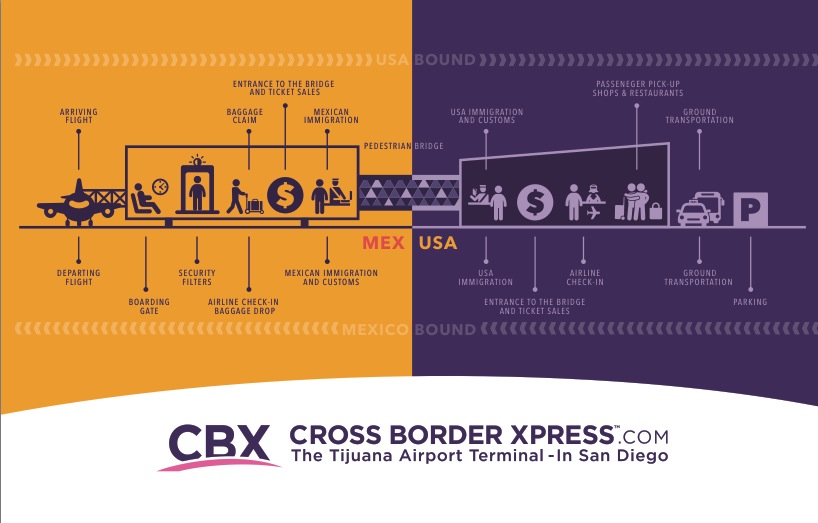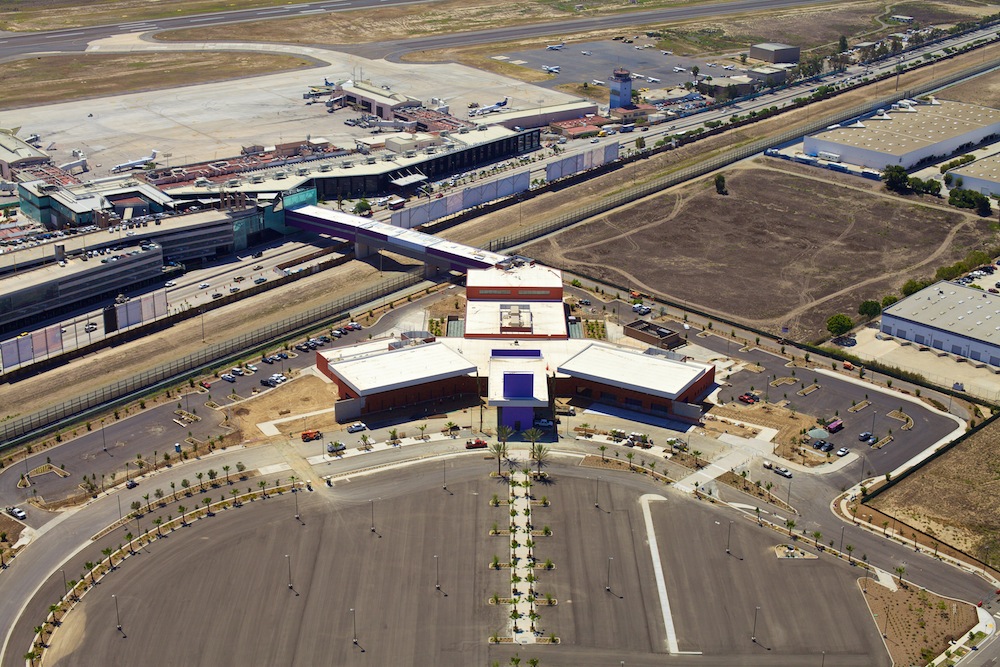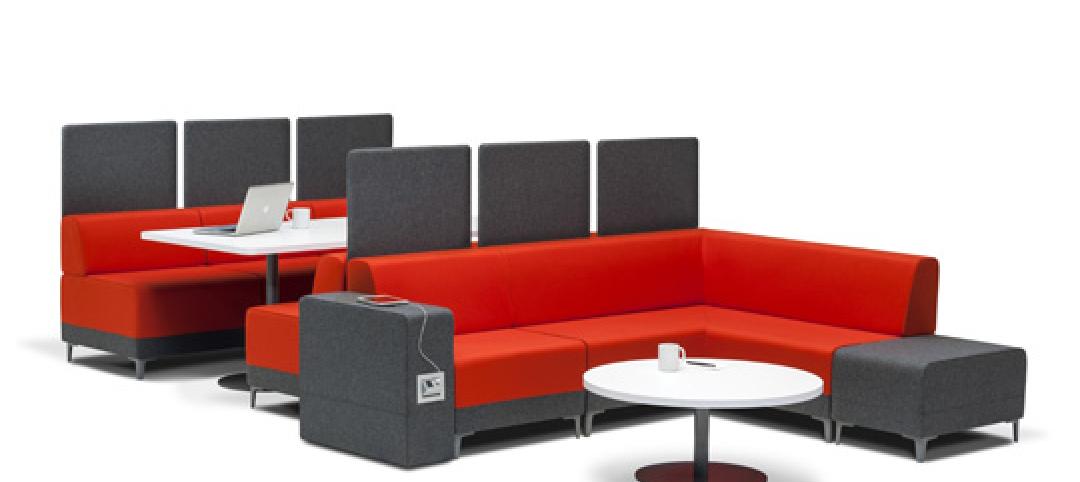The airport in Tijuana, Mexico, is literally within walking distance of the U.S.-Mexico border. And cross-country travel is now a bit easier with the Dec. 9 opening of Cross Border Xpress, a 390-foot-long, 33-foot wide skywalk bridge for use by ticketed airline passengers to cross between San Diego and Tijuana Airport.
This is the first project to join a foreign airport terminal with the U.S., according to the Los Angeles Times, which reports that the $120 million private venture expects to serve 2.4 million fliers annually.
The CBX terminal, located on 55 acres between the border crossings at San Ysidro and Otay Mesa on the California side, is open 24 hours a day, and six airlines—Aeromexico, Aeromexico Connect, Interject, VivaAerobus (a no-frills carrier that doesn’t operate in southern California), Volaris, and Aero Califia—provide customer service.
“A project of this magnitude was no small feat and took cooperation from a large number of stakeholders in the United States and Mexico to make it a reality,” says Jim Kilgore, Senior Associate with Latitude 33, the San Diego-based planning and engineering firm that, in association with Otay-Tijuana Venture LLC, provided land entitlements, construction documents, and construction staking services for this project. “Travel, tourism, business and access to both San Diego and Tijuana will be much improved as a result of this facility.”
Otay-Tijuana Venture is a private investment group with U.S. and Mexican shareholders that include PAP Corp., PALAREO Inc., and EGI-Otay Investors. Invex and Banomext were the lenders for this project.
The CBX facility is a collaboration between the Mexico-based architectural firm Legorreta y Legorreta and Stantec. In Mexico, the contractors included Grumesa, Espazio, Corey and Fercon Qualitas. U.S. contractors included The Harrison Company, Hazard Construction, and Turner Construction.
Here’s how CBX works. Passengers flying into Tijuana International Airport pick up their bags and then purchase or print a CBX ticket at the baggage claim area. (Crossings are free through Dec. 18, and then $18 one way for adults, with discounts for seniors and children.) They can skywalk across the border to the terminal in San Diego County, where they can catch a cab, bus, shuttle or Uber to downtown San Diego, 22 miles away, or other destination points. U.S. Customs mans a checkpoint at the bridge for those people entering the country.
Conversely, passengers coming from San Diego can purchase and print CBX and airline tickets at the full-service terminal, and use the skywalk to access the airport in Mexico, which offers flights to 50 cities.
CBX’s backers estimate that U.S. passengers currently account for nearly 60% of that airport’s customers.
“This will be a great new option for travel between the U.S. and Mexico,” Jerry Sanders, president and CEO of the San Diego Regional Chamber of Commerce, told Fox 5 in San Diego.
The 90,000-sf terminal is the first phase of a 60-acre site that will incorporate two hotel sites, as well as commercial, office, industrial, and shipping facilities over this project’s 10-year buildout.

Related Stories
| Jul 2, 2014
Emerging trends in commercial flooring
Rectangular tiles, digital graphic applications, the resurgence of terrazzo, and product transparency headline today’s commercial flooring trends.
| Jun 30, 2014
Arup's vision of the future of rail: driverless trains, maintenance drones, and automatic freight delivery
In its Future of Rail 2050 report, Arup reveals a vision of the future of rail travel in light of trends such as urban population growth, climate change, and emerging technologies.
| Jun 18, 2014
Arup uses 3D printing to fabricate one-of-a-kind structural steel components
The firm's research shows that 3D printing has the potential to reduce costs, cut waste, and slash the carbon footprint of the construction sector.
| Jun 12, 2014
Austrian university develops 'inflatable' concrete dome method
Constructing a concrete dome is a costly process, but this may change soon. A team from the Vienna University of Technology has developed a method that allows concrete domes to form with the use of air and steel cables instead of expensive, timber supporting structures.
| Jun 2, 2014
Parking structures group launches LEED-type program for parking garages
The Green Parking Council, an affiliate of the International Parking Institute, has launched the Green Garage Certification program, the parking industry equivalent of LEED certification.
| May 29, 2014
7 cost-effective ways to make U.S. infrastructure more resilient
Moving critical elements to higher ground and designing for longer lifespans are just some of the ways cities and governments can make infrastructure more resilient to natural disasters and climate change, writes Richard Cavallaro, President of Skanska USA Civil.
| May 23, 2014
Top interior design trends: Gensler, HOK, FXFOWLE, Mancini Duffy weigh in
Tech-friendly furniture, “live walls,” sit-stand desks, and circadian lighting are among the emerging trends identified by leading interior designers.
| May 20, 2014
Kinetic Architecture: New book explores innovations in active façades
The book, co-authored by Arup's Russell Fortmeyer, illustrates the various ways architects, consultants, and engineers approach energy and comfort by manipulating air, water, and light through the layers of passive and active building envelope systems.
| May 19, 2014
What can architects learn from nature’s 3.8 billion years of experience?
In a new report, HOK and Biomimicry 3.8 partnered to study how lessons from the temperate broadleaf forest biome, which houses many of the world’s largest population centers, can inform the design of the built environment.
| May 13, 2014
19 industry groups team to promote resilient planning and building materials
The industry associations, with more than 700,000 members generating almost $1 trillion in GDP, have issued a joint statement on resilience, pushing design and building solutions for disaster mitigation.

















